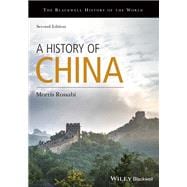Discover the complexity of China’s past with this multi-faceted portrayal of the storied nation from a leading expert in the field
The newly revised Second Edition of A History of China delivers a comprehensive treatment of the political, economic, social, and cultural history of China that covers all major events and trends that have shaped the country over the centuries. The book is written in a clear and uncomplicated style, sure to be of assistance to undergraduate students with little prior background knowledge in the subject matter.
The text examines Chinese history through a global lens to better understand how foreign influences affected domestic policies and practices. It includes discussions of the roles played by non-Chinese ethnic groups in China, like the Tibetans and Uyghurs, and the Mongol and Manchu rulers who held power in China for several centuries.
The distinguished author takes pains to incorporate the perspectives and narratives of people traditionally left out of Chinese history, including women, peasants, merchants, and artisans. Readers will also enjoy the inclusion of:
- A thorough introduction to early and ancient Chinese history, including classical China, the first Chinese empires, and religious and political responses to the period between 220 and 581 CE
- An exploration of the restoration of Empire under Sui and Tang, as well as post-Tang society and Glorious Song
- A discussion of China and the Mongol world, including Mongol rule in China and the isolationism and involvement on the global stage of the Ming dynasty
- A treatment of China in global history, including the Qing era, the Republican period, and the Communist era
Perfect for undergraduate students of courses on Chinese history and Central Asian History, the Second Edition of A History of China will also earn a place in the libraries of students studying global history and related classes in history departments and departments of Asian studies.
The Blackwell History of the World Series
The goal of this ambitious series is to provide an accessible source of knowledge about the entire human past, for every curious person in every part of the world. It will comprise some two dozen volumes, of which some provide synoptic views of the history of particular regions while others consider the world as a whole during a particular period of time. The volumes are narrative in form, giving balanced attention to social and cultural history (in the broadest sense) as well as to institutional development and political change. Each provides a systematic account of a very large subject, but they are also both imaginative and interpretative. The Series is intended to be accessible to the widest possible readership, and the accessibility of its volumes is matched by the style of presentation and production.









